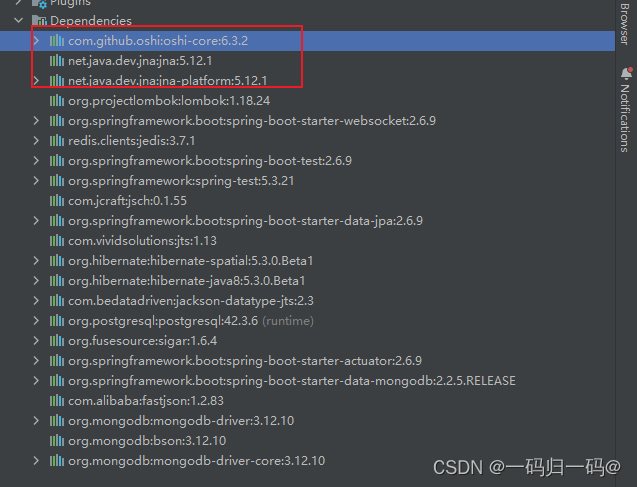文章目录
简介
OSHI 是基于 JNA 的(本地)操作系统和硬件信息库。它不需要安装任何其他额外的本地库,旨在提供一种跨平台的实现来检索系统信息,例如操作系统版本、进程、内存和 CPU 使用率、磁盘和分区、设备、传感器等。
使用 OSHI 可以对应用程序进行监控,可以对应用程序所在的服务器资源进行监控,还可以监控到其他许多指标,如下:
1、计算机系统和固件,底板
2、操作系统和版本 / 内部版本
3、物理(核心)和逻辑(超线程)CPU,处理器组,NUMA 节点
4、系统和每个处理器的负载百分比和滴答计数器
5、CPU 正常运行时间,进程和线程
6、进程正常运行时间,CPU,内存使用率,用户 / 组,命令行
7、已使用 / 可用的物理和虚拟内存
8、挂载的文件系统(类型,可用空间和总空间)
9、磁盘驱动器(型号,序列号,大小)和分区
10、网络接口(IP,带宽输入 / 输出)
11、电池状态(电量百分比,剩余时间,电量使用情况统计信息)
12、连接的显示器(带有 EDID 信息)
13、USB 设备
14、传感器(温度,风扇速度,电压)
支持的平台:
Windows
Linux
macOS
UNIX (AIX, FreeBSD, OpenBSD, Solaris)
相关资料
github 地址:https://github.com/oshi/oshi
API 文档:http://oshi.github.io/oshi/apidocs/
maven依赖
<dependency> <groupId>com.github.oshi</groupId> <artifactId>oshi-core</artifactId> <version>6.3.2</version> </dependency> <dependency> <groupId>net.java.dev.jna</groupId> <artifactId>jna</artifactId> <version>5.12.1</version> </dependency> <dependency> <groupId>net.java.dev.jna</groupId> <artifactId>jna-platform</artifactId> <version>5.12.1</version> </dependency> 
oshi-官方示例
此外,该oshi-demo模块包括一个OshiGui类,它实现了一个基本的 Swing GUI,为在 UI、监控或警报应用程序中使用 OSHI 的潜在可视化提供建议,如下所示。有关基于此方法的更高级 GUI,请参阅MooInfo 项目。
获取CUP信息代码
获取时与windows窗口等查看CUP利用率的信息有差异,本身CUP利用率存在很大的波动。
public static CpuEntity getCpu() throws InterruptedException { SystemInfo systemInfo = new SystemInfo(); GlobalConfig.set(GlobalConfig.OSHI_OS_WINDOWS_CPU_UTILITY, Boolean.TRUE); CentralProcessor processor = systemInfo.getHardware().getProcessor(); long[] prevTicks = processor.getSystemCpuLoadTicks(); // 睡眠1s TimeUnit.SECONDS.sleep(1); long[] ticks = processor.getSystemCpuLoadTicks(); long nice = ticks[CentralProcessor.TickType.NICE.getIndex()] - prevTicks[CentralProcessor.TickType.NICE.getIndex()]; long irq = ticks[CentralProcessor.TickType.IRQ.getIndex()] - prevTicks[CentralProcessor.TickType.IRQ.getIndex()]; long softirq = ticks[CentralProcessor.TickType.SOFTIRQ.getIndex()] - prevTicks[CentralProcessor.TickType.SOFTIRQ.getIndex()]; long steal = ticks[CentralProcessor.TickType.STEAL.getIndex()] - prevTicks[CentralProcessor.TickType.STEAL.getIndex()]; long cSys = ticks[CentralProcessor.TickType.SYSTEM.getIndex()] - prevTicks[CentralProcessor.TickType.SYSTEM.getIndex()]; long user = ticks[CentralProcessor.TickType.USER.getIndex()] - prevTicks[CentralProcessor.TickType.USER.getIndex()]; long iowait = ticks[CentralProcessor.TickType.IOWAIT.getIndex()] - prevTicks[CentralProcessor.TickType.IOWAIT.getIndex()]; long idle = ticks[CentralProcessor.TickType.IDLE.getIndex()] - prevTicks[CentralProcessor.TickType.IDLE.getIndex()]; long totalCpu = user + nice + cSys + idle + iowait + irq + softirq + steal; CpuEntity cpuEntity = new CpuEntity(); cpuEntity.setSys(new DecimalFormat("#.##").format(cSys * 1.0 / totalCpu)); cpuEntity.setUser(new DecimalFormat("#.##").format(user * 1.0 / totalCpu)); cpuEntity.setWait(new DecimalFormat("#.##").format(iowait * 1.0 / totalCpu)); cpuEntity.setWait(new DecimalFormat("#.##").format(idle * 1.0 / totalCpu)); // user + system + nice + iowait + irq + softirq + steal long cpuUtilization = user + nice + cSys + iowait + irq + softirq + steal; cpuEntity.setCombined(new DecimalFormat("#.##").format((cpuUtilization * 1.0 / totalCpu)*100)); return cpuEntity; } 获取内存信息
public static MemoryEntity getMemory() { OperatingSystemMXBean osmxb = (OperatingSystemMXBean) ManagementFactory.getOperatingSystemMXBean(); MemoryEntity memoryEntity = new MemoryEntity(); memoryEntity.setMemTotal(osmxb.getTotalPhysicalMemorySize() / 1024 / 1024 / 1024); memoryEntity.setMemUsed((osmxb.getTotalPhysicalMemorySize() - osmxb.getFreePhysicalMemorySize()) / 1024 / 1024 / 1024); return memoryEntity; } 获取磁盘信息
File[] roots = File.listRoots(); Long useSum = 0l; Long totalSum = 0l; for (File file : roots) { long free = file.getFreeSpace(); long total = file.getTotalSpace(); long use = total - free; useSum += change(use); totalSum += change(total); } 